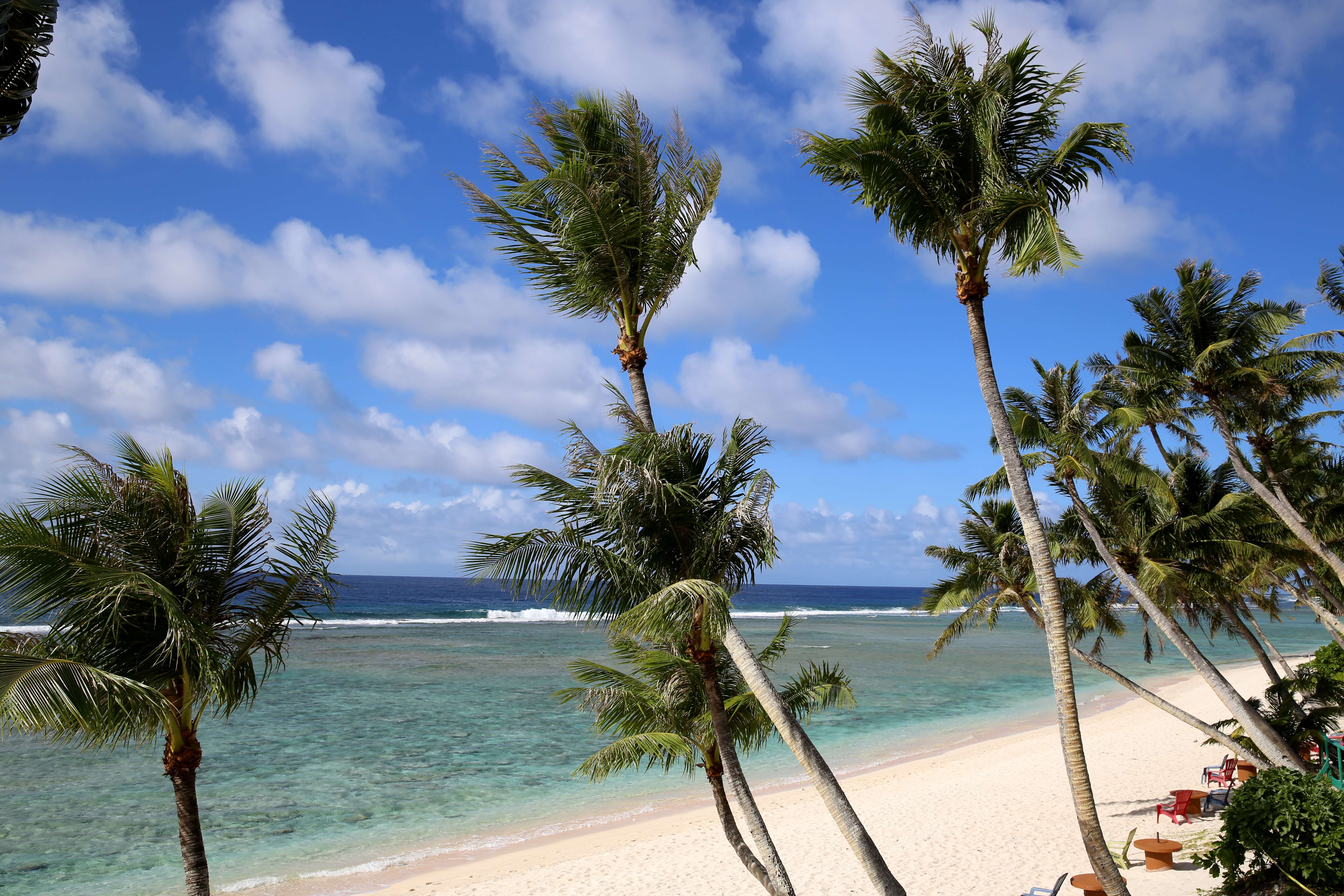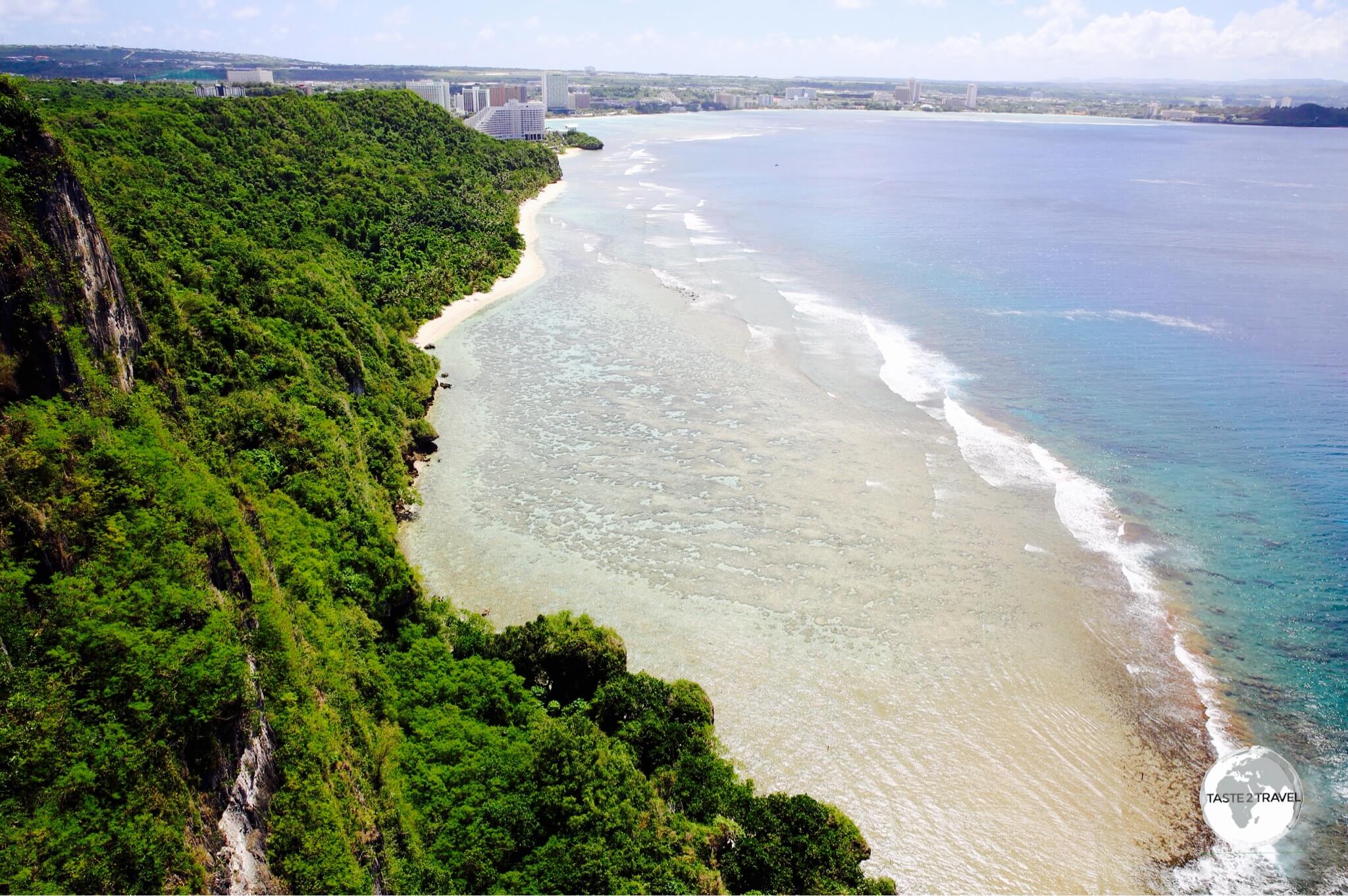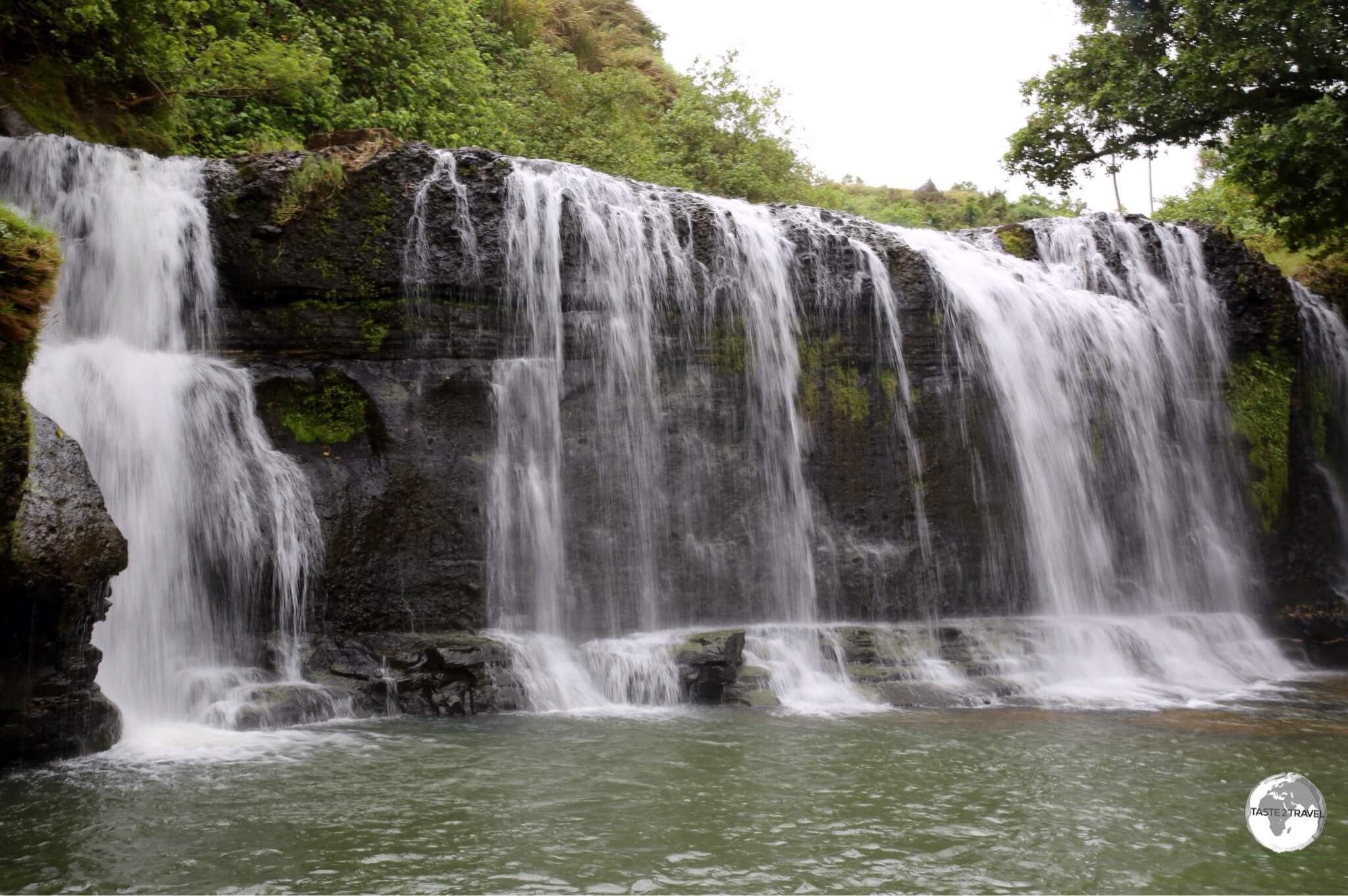Guam Travel Guide
Welcome to the taste2travel Guam Travel Guide!
Date Visited: February 2017
Introduction
If you’ve spent time on neighouring islands in Micronesia, you will have become use to a sleepy, laid-back, slow-paced way of life. Guam however is bright lights, big city buzz – a mini Hawaii – and will snap you out of any relaxed, comatose state you may have gotten use to.
Here you will find busy, congested highways, lined with shopping malls (anchored by stores such as Macy’s) and all the usual US chain restaurants. Expensive, high-rise resorts, which cater to a throng of Japanese and Korean tourists, line the shore of emerald-coloured Tumon bay (Guam’s version of Waikiki).

View from Two Lovers Point.
Added into this mix are approximately 7,000 US military personnel (and their families) who are stationed at either Anderson Air Force base in the north or Naval Base Guam on the east coast.
While on Guam it is impossible to escape the US military presence – in any restaurant you will most likely be dining alongside soldiers and their families, bars are full of soldiers and to get to these places you travel along roads such as South Marine Corps Drive, Army Drive etc.

Souvenir of Guam.
Guam (population: 160,000) is the biggest and busiest island in Micronesia. The island is an unincorporated and organised territory of the United States (i.e. Guam is controlled by the US government but is not fully part of the United States – as such the US Constitution applies only partially). The official currency is the US dollar.
Guam is a fun place to spend a week, with many different attractions on land and in the pristine, tropical waters which surround the island. Being a US territory – services and infrastructure are well developed, which makes for easy travelling.
Location
Located in the western Pacific (north of the equator, three-quarters of the way from Hawaii to the Philippines), Guam is the southernmost island in the Mariana island chain.
Located off the east coast of the island is the Mariana Trench, which reaches it’s deepest point (10,911 metres/ 35,797 feet) at Challenger Deep, the deepest point on the planet.
In 2012, famous Canadian film maker, James Cameron, was the first human to travel 11 km (6.8 miles) down into the depths of Challenger Deep on a solo voyage in a specially built submarine.
History

Magellan’s obelisk at Umatac bay.
Guam was settled around 2,000 BC by native Chamorros who are believed to have come from Southeast Asia and today comprise 38% of the total population.
The first European contact was in 1521 when Ferdinand Magellan landed on the island – it is here where Magellan encountered the first “indios” since leaving South America.
Despite Magellan’s initial visit, the island was not colonised by Spain until the 17th century who then used it as a stopover point for their Spanish Manila Galleons, which sailed between Mexico and the Philippines.
During the Spanish period, many Filipinos settled on Guam and today comprise 27% of the population.
In 1898 the Spanish surrendered Guam to the United States as part of the settlement of the Spanish-American War. However, the island was then captured during WWII by Japan, just hours after the attack on Pearl Harbour.
The Japanese occupied Guam for the next two-and-a-half years, before U.S. troops were able to recapture the island in 1944. The Americans have been in control every since.
Today, Guam is supported by its tourism industry, with its second largest source of income coming from the United States Armed Forces.
Flag

The flag of Guam.
The flag of Guam is dark blue with a red border on all sides. At the centre, the coat of arms of Guam is an almond-shaped emblem, which depicts a proa (traditional sailing boat) sailing in Agana Bay and GUAM coloured in red letters.

The flag of Guam flying in the capital, Hagåtña.
Sightseeing

I too was a ‘fan’ of Guam beer!
For sightseeing, Guam can be split into three regions:
Northern Region
A large chunk of the northern region is off limits to visitors as its home of the Andersen Air Force Base (AFB), with the base stretching along the entire north coast. One place worth visiting is Ritidian beach on the the north-east coast.
The road to the beach is a pot-holed, rough, gravel road, which follows the perimeter fence of the AFB. While I was bouncing along this road I could look over into the base where I could see a perfectly paved road with absolutely no traffic.
While back-roads on the island can be rough, it seems roads on the bases are in perfect working order.
Ritidian beach is home to the Guam National Wildlife Refuge Unit which provides two miles of coastal walking trails. The refuge is open daily until 4pm. After this time, a locked gate on the main road prohibits any access to the entire area, so best to come during refuge opening hours.

Coco Palm Garden Beach
Another, much rougher, gravel road (left turn before the refuge gate) follows Ritidian beach.
I drove my (rental) car along this road but it really is only suited to 4WD. Most of the beachfront property is private with fences, gates and ‘no trespassing‘ signs lining the way.
There is nowhere along this road which provides public access to the beach. If you persevere, you’ll eventually reach Coco Palm Garden Beach. This is one over-priced tourist trap. For around $90 each, Japanese and Korean tourists are bussed in from their Tumon Bay resorts, provided a welcome drink, BBQ lunch, access to the beach (rocky/ coral reef), towel and fish food (?).
The whole place closes down early in the afternoon to ensure all tourists are back at their resorts in time for their dinner shows. I arrived at 4pm and was allowed 2 minutes of free access to take one photo of the beach. The staff were not at all welcoming and certainly not happy that I was getting free access.
On West Marine Corps drive in Dededo is the Micronesia Mall – the largest mall on the island.
Okay – if you have arrived on Guam from the real world then this mall will not seem to be anything special, but for those who have spent an inordinate amount of time on any of the sleepy, less-developed neighbouring islands – this is big deal.

Signed love hearts at Two Lovers Point
Just north of Tumon Bay is Two Lovers Point, a dramatic (400 ft) coastal cliff from which it is said two lovers jumped to their death as the father of the girl wanted her to marry a Spanish captain which she refused in the most dramatic way possible.
The views over the Philippine Sea and nearby Tumon Bay are spectacular, as are all the colourful love-heart shaped dedications written by visiting romantic tourists.

View south to Tumon Bay from Two Lovers Point.
Central Region
This is where all the action is and where you will spend most of your time. The central region is home to the tourist hub of Tumon Bay and to the island’s capital – Hagåtña.
Tumon Bay

View of Tumon Bay
With its stretch of high-rise resorts wrapping around the bay, Tumon is all about rest, relaxation, play and shopping. In between the resorts are large duty free shops catering to the needs of free-spending Japanese and Korean tourists.
It’s here you’ll find US chain restaurants, Sushi & Korean BBQ restaurants, bars & clubs, spas, dinner theatres, speciality shops an Underwater World and everything else package tourists might need to enhance their tropical escape experience.

Tumon Bay Beach
During the day, the bay offers fantastic snorkeling – once you get well offshore (unfortunately too many tourists standing on the flat coral heads has killed all the coral close to shore).
Although I wasn’t staying there, I was able to hire snorkel gear from the aquatic sports shop at the Hilton hotel and snorkel directly in front of the hotel (best snorkeling is out to sea from the cove).
Hagåtña

The very modern, Guam Museum, is located in the heart of Hagåtña, the capital of Guam.
Guam’s capital is a small, relaxed, town which features a historic walking path, connecting all sights of interest. A good place to start is the impressive Guam Museum – the museum tells the history of the island. Directly outside the museum is a sculpture commemorating the visit of Pope John Paul II to the island in 1981.
Across the road from the museum is the historic Plaza de Espana, which was the location of the Governor’s Palace during the island’s period of Spanish occupation.
The palace housed the office and residence of the Spanish governor but was largely destroyed during the liberation of Guam in 1944. Today a few structures remain, including the the Chocolate House, the “Azotea” and the Almacen gate.

Statue of Pope John Paul II and Dulce Nombre de Maria Cathedral Basilica in Hagåtña
Next to Plaza de Espana, is the contemporary Dulce Nombre de Maria Cathedral-Basilica while behind the Plaza is the Senator Angel Leon Guerrero Santos Memorial Park.
The park contains 8 ancient lattes. Nothing to do with coffee – latte’s were used in the Mariana islands as house supports, with a cap at the top to discourage rats and other vermin climbing up into the house.

Weekly BBQ at the Chamorro village.
Towards the harbour, the Chamorro village is a great place for souvenir shopping and (only on Wednesday evenings) the best BBQ in town. The best time to visit is early in the evening with lots of pop-up shops and BBQ vendors.
The earlier you order food the better as the lines get progressively longer as the night goes on, with everyone from locals, tourists and military families turning out.
Southern Region
The southern part of the island features small, quiet coastal hamlets built around picturesque bays. I covered this part of the island on a leisurely day trip following a circuitous route from Hagåtña by first crossing the island on highway 4 to the east coast (Pago Bay) then travelling clockwise around the bottom of the island back to Hagåtña.
The east coast lies on the windward side of the island hence the beaches are much more dramatic and exposed than those on the west coast.

Talofofo Falls.
In Talofofo bay, Talofofo falls are worth the short detour off the coastal road. The falls consist of a series of scenic cascades on the Talofofo River and are reached by way of a very lazy cable car which transports you down into the gorge where the falls are located.
A series of paths and bridges leads you around the falls back to the cable car.

Entrance to Yokoi’s cave.
Also at the falls is “Yokoi’s Cave“, a replica of the original cave, which was located at the same sight but previously destroyed by a typhoon.
This fascinating survival story involves a Japanese soldier who survived the US liberation of the island in 1944 by hiding in a small cave in the jungle. Yokoi survived for the next 27 years, sourcing water from the river and food from the jungle until he was discovered in 1972 by two local hunters.
He believed Japan was still at war and didn’t want to surrender. He eventually returned to Japan to a hero’s welcome (and to receive $300 in back pay).

Fort Nuestra Senora de la Soledad.
As you travel around the southern tip of the island onto the west coast, highway 4 becomes highway 2 as you enter Umatac bay.
This picturesque bay was where Magellan landed in 1521. At the centre of the bay is an obelisk monument commemorating his landing, bearing the inscription, “Magellan landed here.”
It was also here in 1565 that Miguel Lopez de Legazpi dropped anchor and stayed for thirteen days, formally claiming Guam for Spain.
On either side of the bay are two forts (Fort Nuestra Senora de la Soledad and Fort Santo Angelo), which were built during the Spanish colonial period to protect the bay from pirates and other European explorers.
Continuing north along the west coast you’ll soon reach Naval Base Guam. Next to the entrance of the base is the T. Stell Newman Visitor Centre, part of the War in the Pacific National Historical Park.
The friendly, informative staff can provide you with a map of the park and information on what to see. Most of the points of interest (former battlefields, trenches and historic structures) lie along the coast north of the Naval base. The park tells the story of war in the Pacific and details the US liberation of Guam in 1944, which resulted in the defeat of the Japanese.
Accommodation

Most visitors to Guam stay in expensive resorts – such as the Guam Hilton – on beautiful Tumon Bay, the Waikiki of Guam.
Most hotels on the island are located along the long curving shore of beautiful Tumon bay, a short drive from the airport.
These hotels are large scale, high-rise resorts which cater to Japanese, Korean and (increasingly) Chinese tourists who jet in for a few days of rest and relaxation.
These tourists arrive on fully escorted tours with lots of money to spend in a short time, hence hotels around the bay are never cheap. If you wish to check these options, you will find them on sites such as booking.com
I used Airbnb to find a more reasonably priced apartment, which was perfect for my stay
Eating Out
Thanks to it being a US territory (and home-away-from-home for thousands of military personnel and their families), Guam offers more dining options than any other island in Micronesia.
All the usual US chain restaurants are represented on the island. You can start your day with breakfast at Denny’s, lunch at Apple-Bee’s and finish with dinner at the Texas Steakhouse. Its a glutton’s paradise!
Added into the mix are numerous Japanese and Korean restaurants in Tumon Bay, which cater to the throngs of Japanese and Korean tourists.

Lunch at McKraut’s German restaurant in Inarajan.
If you’re in the mood for fine German cuisine, you cannot go past the legendary McKraut’s German restaurant, which is located in the village of Inarajan on the remote south-east coast.
The drive from Tumon Bay is about an hour but if you are exploring the south east coast then this is the perfect place to stop for lunch or dinner.
One ‘must do’ culinary experience on the island is the weekly BBQ at the Chamorro village in Hagåtña (see that section for more details).

Bar at McKraut’s German restaurant
For a taste of local Chomoro cuisine, the Meskla Chamoro Bistro in Hagåtña is an excellent choice. The restaurant was founded by a local celebrity chief (Peter Duenas) who’s aim has been to highlight Chomoro cuisine. This is a popular place so reservations are recommended.
Visa Requirements
Entry requirements for Guam are the same as the USA . Check your visa requirements prior to arrival.
Getting There

The view from my flight on United Airlines “Island Hopper” (UA154) on final approach to Guam.
By Air
Flights to Guam arrive at Antonio B. Won Pat International Airport (named after the first delegate from Guam to the United States House of Representatives). The airport is built on a high ridge above Tumon Bay and is within a three hour flight of major Asian cities in Japan, Korea, China, Taiwan and the Philippines.
The airport serves as a regional hub for United Airlines, however most flights are operated by Korean and Japanese carriers who carry hoards of holiday-makers to the island each day.
Guam airport is the terminus for the epic United Airlines Island Hopper (UA154) – for more on this, please refer to my Central Pacific Island Hopping blog.
The following airlines provide connections to/from Guam:
- Air Busan – flight to Busan
- Cebu Pacific – flight to Manila
- China Airlines – flight to Taipei–Taoyuan
- Delta Air Lines – flight to Tokyo–Narita
- EVA Air – flight to Taipei – Taoyuan
- HK Express – flight to Hong Kong
- Japan Airlines – flight to Tokyo–Narita
- Jeju Air – flights to Busan, Seoul–Incheon
- Jin Air – flights to Busan, Seoul–Incheon
- Korean Air – flights to Osaka–Kansai, Seoul–Incheon
- Philippine Airlines – flight to Manila
- Star Marianas Air – flights to Rota, Saipan
- T’way Airlines – flights to Daegu, Osaka–Kansai, Seoul–Incheon
- United Airlines – flights to Chuuk, Fukuoka, Hong Kong, Honolulu, Koror, Kosrae, Kwajalein, Majuro, Manila, Nagoya–Centrair, Osaka–Kansai, Pohnpei, Sapporo–Chitose, Sendai, Shanghai–Pudong, Tokyo–Narita, Yap
- United Express – flights to Rota, Saipan
Getting Around

The license plate on my rental car.
Bus
The Guam Regional Transit Authority operates inexpensive public buses which cover most places on the island. Services are not very frequent and only operate Monday – Saturday (no service Sunday or public holidays). If you wish to maximise your time on the island then car rental is the best option.
Taxi
Taxis are available in the main tourist areas with a fare from the airport to Tumon Bay costing about $6.
Rental Car

The best way to explore Guam is with a rental car.
While public buses provide island-wide service, many attractions are off the beaten track, hence the best way to explore Guam is with a rental car.
Daily charges on Guam are much more reasonable than those on neighbouring islands, with all the main rental companies operating from the airport. I hired a car through Alamo at a very competitive rate. Signage on the island is poor (typical for the region) so either a good map or navigation device is recommended.
That’s the end of my Guam Travel Guide.
Safe Travels!
Darren
Follow me on Instagram:
[instagram-feed feed=1]
Further Reading
- Other travel reports from the Pacific region:
Guam Travel Guide Guam Travel Guide Guam Travel Guide Guam Travel Guide Guam Travel Guide Guam Travel Guide Guam Travel Guide Guam Travel Guide Guam Travel Guide
Author: Darren McLean
Darren McLean is an Australian, full-time, digital nomad who has spent 37 years on a slow meander around the globe, visiting all seven continents, 192/ 193 UN countries and 245/ 251 UN+ countries and territories.
He founded taste2travel to pique one’s curiosity and inspire wanderlust.







